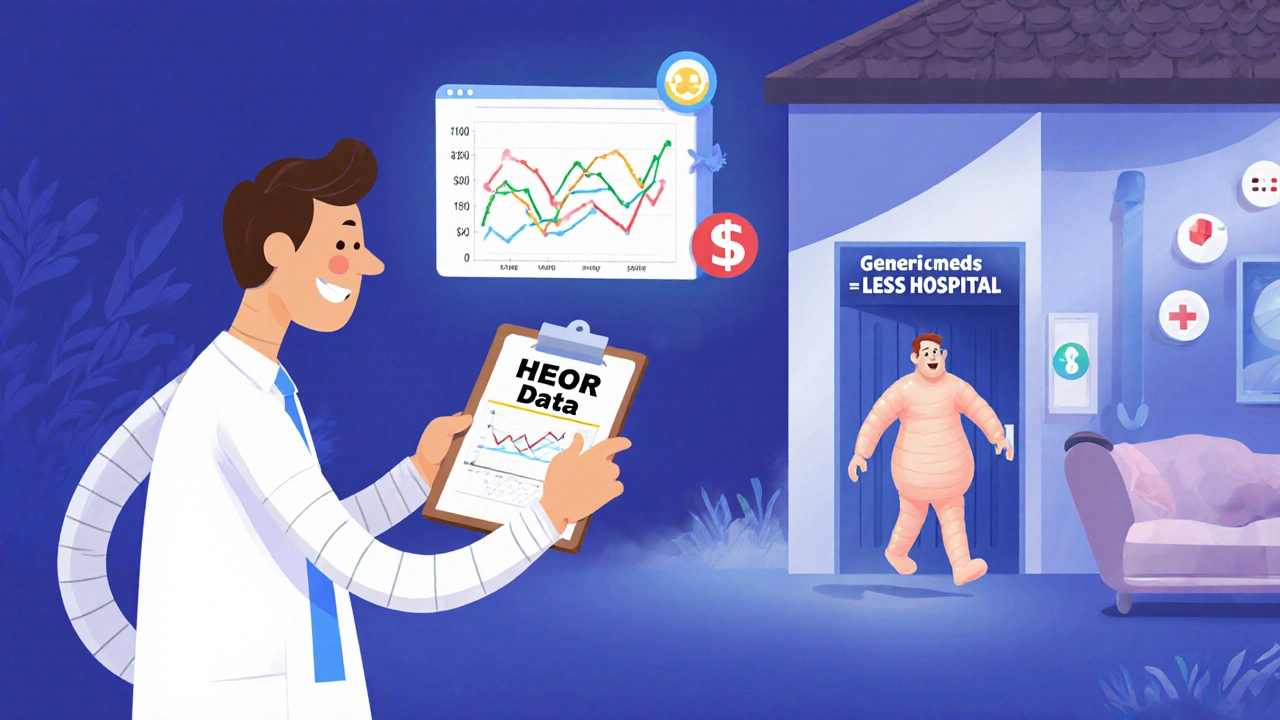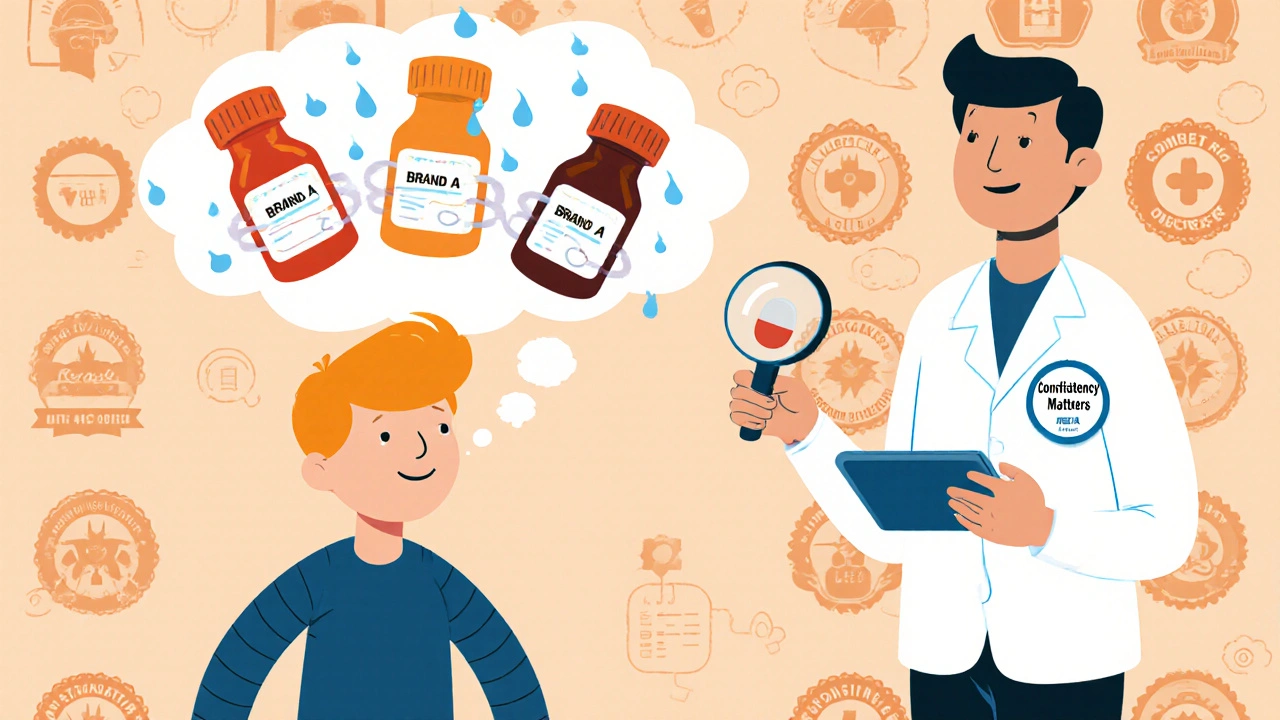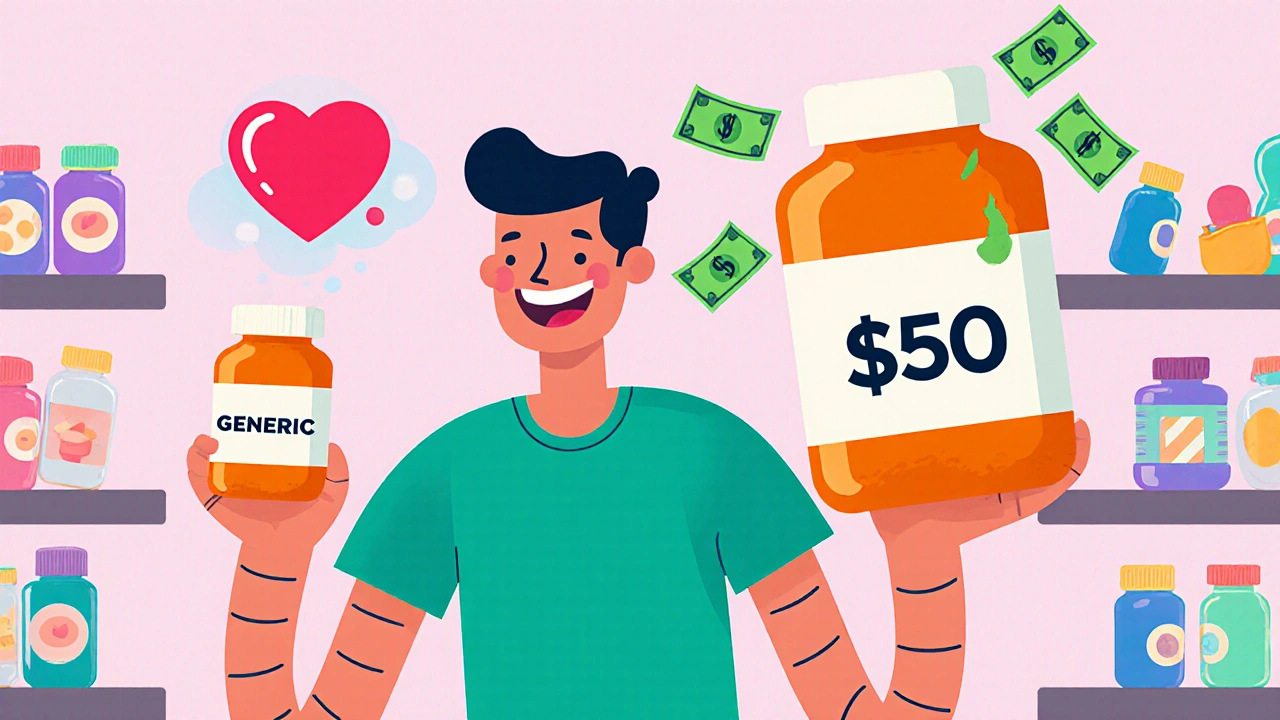When you pick up a prescription, you might see two options: the brand-name drug you’ve heard of, or a cheaper generic version. The price difference can be huge - sometimes 80% less. But is saving money really saving you money in the long run? This isn’t just about what’s on the sticker at the pharmacy. It’s about generic medications, how they perform in real life, and whether they actually reduce overall healthcare costs - or just shift them somewhere else.
What Does "Cost-Benefit" Really Mean for Generic Drugs?
Most people think cost-benefit is simple: cheaper drug = better deal. But in health economics, it’s way more complex. The field called Health Economics and Outcomes Research (HEOR) looks at three things: economic costs, clinical outcomes, and humanistic impacts - that means how patients feel, how well they stick to their meds, and whether they end up in the hospital. A generic drug doesn’t need to be identical to the brand name. It just needs to be bioequivalent - meaning it delivers the same amount of active ingredient into the bloodstream within a narrow range (80-125% of the brand). The FDA requires this. But bioequivalence doesn’t guarantee identical results in real life. Why? Because inactive ingredients - fillers, dyes, coatings - can affect how the drug is absorbed. For most people, it doesn’t matter. For others, it can mean the difference between stable control and a flare-up. Studies show that when patients switch to generics, adherence improves by 5-15%. Why? Because they’re more likely to fill the prescription if it costs $5 instead of $50. And better adherence leads to fewer emergency visits, fewer hospital stays, and fewer complications. For someone with high blood pressure or diabetes, that can mean avoiding a stroke or kidney failure - which cost tens of thousands of dollars. So even if the drug itself is cheaper, the real savings come from what it prevents.How Much Money Are We Actually Saving?
In the U.S., generics make up 90% of all prescriptions but only 22% of total drug spending. That’s a massive shift. A 2023 report from IMS Health showed that commercial insurers saved $1,200 to $1,800 per member per year just by pushing generics through their formularies. Medicare Part D plans, which cover 65 million Americans, require HEOR data before covering any new drug - and they almost always choose generics. But savings aren’t automatic. If a patient can’t afford their generic because of high copays, or if their doctor won’t prescribe it because they’re worried about effectiveness, the savings disappear. That’s why HEOR doesn’t just look at drug prices. It looks at the whole picture: how often prescriptions are filled, how many patients switch back to brand names, and whether those switches lead to more doctor visits. One 2024 analysis found that when generic market share hits 70% or higher for a chronic condition like asthma or depression, total treatment costs drop by 12-18%. That’s not just drug costs - it’s ER visits, lab tests, specialist appointments, and lost workdays. A patient who can afford their medication is less likely to end up in the hospital. And that’s where the real value is.Where Generics Fall Short - The Hidden Costs
It’s not all good news. For drugs with a narrow therapeutic index - like warfarin, levothyroxine, or seizure medications - even tiny changes in blood levels can cause serious problems. A 2024 AMA survey found that only 47% of primary care doctors feel comfortable switching patients on these drugs to generics. Why? Because the margin for error is razor-thin. One study showed that 3-5% of patients on levothyroxine stopped taking their medication after switching to a generic, not because it didn’t work, but because they felt different - and didn’t know why. Patient reviews on Drugs.com and WebMD show that while 89% of people prefer generics when the price difference is over $20, 68% of negative reviews claim the generic “didn’t work as well.” That’s not necessarily true from a clinical standpoint - bioequivalence studies say otherwise. But perception matters. If a patient believes the generic is weaker, they may stop taking it, or report worse symptoms. This is called the “therapeutic misconception,” and it’s a real problem in HEOR studies. It’s not about the drug. It’s about trust. Then there’s the cost of switching. When a patient goes from one generic to another - which happens often because pharmacies change suppliers to get the lowest price - some patients experience side effects or instability. One Reddit thread with over 1,200 comments from people who switched generics reported that 42% had personal experiences with new side effects: headaches, rashes, nausea. These aren’t always documented in clinical trials. They show up in real life - and they cost money to fix.
How HEOR Evaluates Generics - Beyond the Price Tag
HEOR doesn’t just compare sticker prices. It uses three main tools:- Cost-effectiveness analysis (CEA): Measures cost per quality-adjusted life year (QALY). In the U.S., a treatment is usually considered cost-effective if it costs less than $50,000-$150,000 per QALY gained. Generics almost always pass this test - often by a huge margin.
- Budget impact analysis (BIA): Projects how much a health plan will save (or spend) over 1-5 years if it switches to generics. This includes price differences, volume changes, and downstream costs like hospitalizations.
- Comparative effectiveness research (CER): Uses real-world data from electronic health records and insurance claims to compare actual patient outcomes. Did patients on the generic have fewer heart attacks? Did they refill their prescriptions more often?
Who’s Using HEOR - And Who’s Not
The adoption gap is wide. Pharmacy Benefit Managers (PBMs) use HEOR for nearly all formulary decisions. Medicare Part D plans require it. But only 35% of physician practices use HEOR data when choosing generics for patients. Why? Because it’s complicated. Doctors don’t have time to read 50-page reports. They need simple answers: “Is this safe? Will it work?” Some health systems are starting to solve this. They’re building dashboards that show doctors a quick summary: “This generic has 92% adherence rate, 14% lower hospitalization risk, and costs $12 less per month.” That’s the future. Not raw data - clear, actionable insights. AI is helping too. Companies like Komodo Health and Flatiron Health are using machine learning to predict which patients are most likely to respond well to a generic based on their history, age, comorbidities, and even social factors like income and transportation access. This moves HEOR from population-level analysis to personalized recommendations.
What Patients and Providers Should Know
If you’re a patient: Generics are safe and effective for most medications. If you notice a change after switching - fatigue, mood swings, new side effects - talk to your pharmacist or doctor. Don’t assume it’s “all in your head.” Sometimes, it’s the filler. Sometimes, it’s just your body adjusting. But it’s worth investigating. If you’re a provider: Support generic use - but don’t assume all generics are the same. For high-risk drugs, stick with the same manufacturer if the patient is stable. Keep an eye on adherence. If a patient stops refilling, ask why. Is it cost? Side effects? Confusion? The answer might not be in the prescription pad - it’s in the conversation. If you’re a payer: Aggressive generic formularies save money - but only if patients can access and stick with them. Lower copays, clear communication, and patient education matter as much as the price difference.The Bottom Line: Generics Work - But Only If They’re Used Right
The data is clear: generic medications save billions every year. They reduce hospitalizations, improve adherence, and make treatment possible for people who otherwise couldn’t afford it. But savings aren’t guaranteed. They depend on trust, consistency, and good communication. HEOR gives us the tools to prove it. But the real win comes when patients, doctors, and payers all understand that the cheapest drug isn’t always the best - but the one that’s taken consistently, safely, and affordably? That’s the one that changes lives.Are generic medications as effective as brand-name drugs?
Yes, for the vast majority of medications, generics are just as effective. The FDA requires them to deliver the same active ingredient in the same amount and at the same rate as the brand-name version. Bioequivalence studies prove this. However, for drugs with a narrow therapeutic index - like warfarin, levothyroxine, or certain seizure medications - even small differences in absorption can matter. In these cases, consistency in manufacturer matters more than switching between generics.
Why do some people say generics don’t work for them?
There are a few reasons. First, inactive ingredients - like dyes or fillers - can cause side effects in sensitive individuals. Second, switching between different generic manufacturers can cause small changes in how the drug is absorbed, leading to symptoms like headaches or nausea. Third, the placebo effect works both ways: if a patient believes a generic is inferior, they may perceive it as less effective, even if the clinical data says otherwise. This is called the therapeutic misconception.
Do generics save money for patients or just for insurers?
Both. Patients pay less out of pocket - often $5-$15 per month instead of $50-$100. Insurers save even more because lower drug costs lead to fewer hospitalizations, ER visits, and complications. For chronic conditions like diabetes or high blood pressure, better adherence due to lower cost can reduce total care costs by 12-18%. So the savings ripple through the whole system.
Should I always choose the cheapest generic?
For most drugs, yes. But if you’re on a medication where small changes matter - like thyroid, seizure, or blood thinner drugs - ask your doctor if you should stick with one manufacturer. Some pharmacies switch suppliers to get the lowest price, which can lead to instability. If you notice changes in how you feel after a switch, don’t ignore it. Talk to your pharmacist or provider.
How do health plans decide which generics to cover?
Large plans use Health Economics and Outcomes Research (HEOR) to evaluate not just price, but real-world outcomes. They look at adherence rates, hospitalization data, patient-reported outcomes, and total cost of care. The goal isn’t just to pick the cheapest drug - it’s to pick the one that leads to the best health outcomes at the lowest total cost. PBMs and Medicare Part D plans use this approach. Most doctors don’t - yet.
Is HEOR only for big companies and insurers?
Not anymore. While HEOR was once only used by large payers and pharmaceutical companies, new tools are making it more accessible. AI-powered platforms now give doctors quick summaries of generic performance based on real-world data. Some clinics are starting to use dashboards that show which generics have the highest adherence and lowest complication rates. The goal is to bring evidence-based decisions into everyday practice - not just boardrooms.


Post A Comment